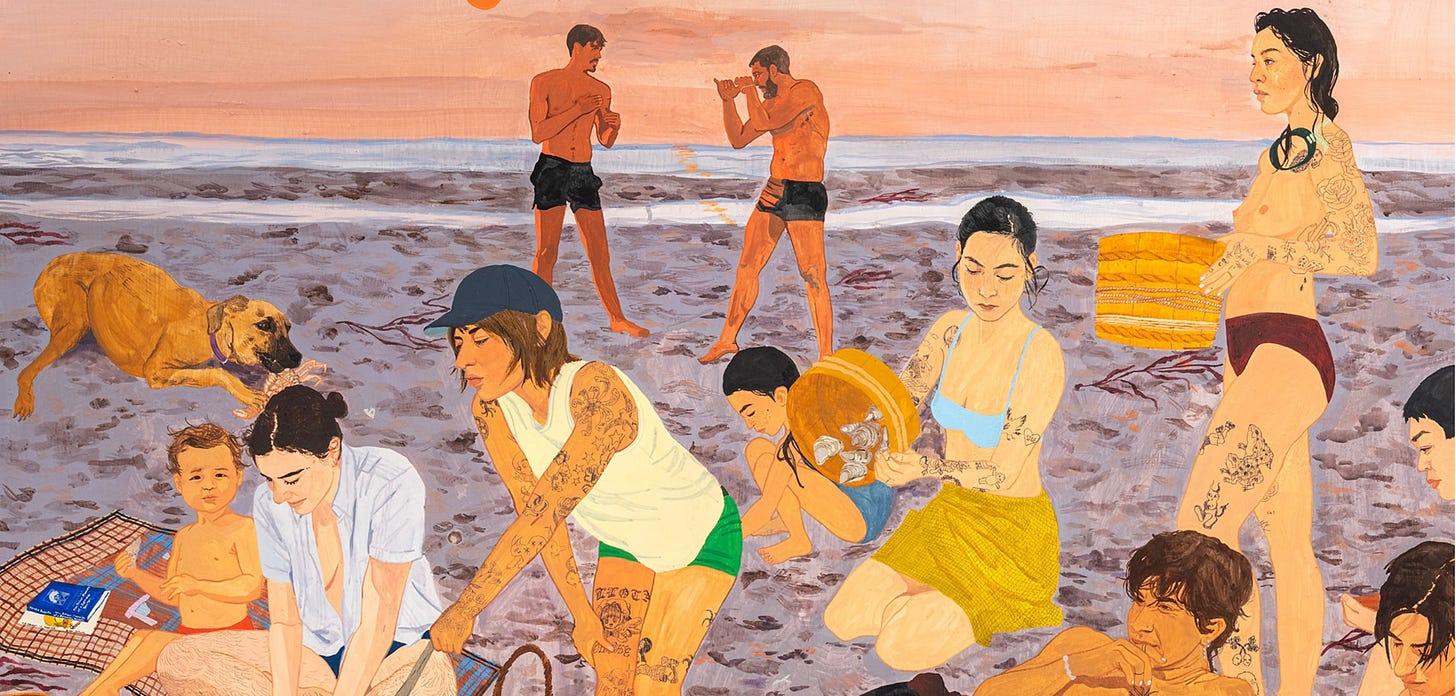On the day Elon Musk and Donald Trump broke up — which was yesterday, actually, as of this writing — I stood in the MARCH gallery in Manhattan, having walked up Essex and then Avenue A after getting off the bus in Chinatown. I looked at paintings. The exhibition was “Enemy of the Century,” by Dianna Settles. As I stood by the one you see below this paragraph, two guys who had come in after me and seemed like a couple stopped to look and one of them said to the other “this is like if there was a beach in Bushwick.”
I recognized a vibe: people with tattoos, reading radical texts, wearing things they likely thrifted, living their own way and seeking —perhaps futilely — nature and community. Other paintings in the exhibit showed scenes from an imagined commune: a bulletin board with the schedule, people working in a shared garden, raising children together. I recognized in these images of an idealized communal life something of my own generational and cultural experience. All of my friends and I have said, at some point, they want to go off the grid, throw away their phone, try van life. To me, the paintings envision what such a life would look like, one possible young progressive response to the world’s chaos — and they represent the doubts we feel around it.
The piece is titled: What’s left? This season of heat and wind, this dinner tonight, and those large bands of trembling waves of various shades of green that split my heart with their incredible beauty. We’re witnessing the last days of civilization as we know it.
The message that I read in the painting of the beach feels almost like a thesis sentence you’d write in a high school paper: “The men in the background represent the world’s conflicts, and we in the foreground are doing our best to live without letting that get to us.” The two men in the back were Elon and Trump that day.
There is nobility to the acts of tending, gathering, and nurturing that the people in the foreground are doing. But in the painting, there is also ambiguity, maybe? As the folks in the foreground tend to children, do their chores, and lounge about, their eyes turn either to the ground or off into space. Nobody looks happy. I see an anxiety. I feel the fragility, the performativity of their community making.
I’ve seen many posts talking about the cliché of “community” in Millennial and Gen Z culture writing. On the one hand, the word has been commodified by platforms and creators. On the other (and this is a sin I’m guilty of) it’s been offered as a kind of vague panacea, as in: “online content is isolating and upsetting you, let’s build community instead.” People idealize community, and yet ultimately prefer to be alone on their phones most of the time. Three generations past the moment in American history when society atomized into nuclear families, two generations after the decay of unions and civic organizations, and a generation into the social corrosion of slop capitalism, we find ourselves awkwardly reaching for an ideal of “community” that, since our historical experience has left us ill-equipped to understand it, we talk about as a political abstraction, in the same way leftists talk about “the revolution.”
You go to your shift at the co-op or pick up your radical zine and say to yourself, “I’m so happy to be at the co-op,” or “so happy to be raising awareness” but it never feels full. You go through the motions of making your life look like something more organic, more loving, more ethical in its consumption, more wholesome and connected, but it can never entirely cohere, never entirely convince.
At the independent bookstore down the block from the gallery, I flipped through some photography books and a poetry compilation, then found What Have You Left Behind? by Bushra al-Muqtari, a collection of firsthand oral histories of the war in Yemen. I read a three-page story of a mother who saw her two daughters killed by a shell as they walked less than a step behind her down the street. She keeps the door to the girls’ bedroom, next to the kitchen in the house she still lives in, closed.
The only figure who looks at us dead-on is the child in the lower-left corner. The iPad baby, the Skibidi watcher. The dog mauling a crab might also be kind of looking at you.
Settles’s composition draws attention to the two fighting men, who stand at the tip of a pyramid formed by all the people. My eye starts with the business in the foreground, then travels to the fighting men at the point of the triangle structure, then is pulled to the standing woman on the right, who counterpoints them. The standing woman (who figures in several other paintings in the collection, some of which show her pregnant) gives the painting a kind of imbalance, the right side is heavier and brighter than the left. And the framing — which cuts off some people in the middle of their faces — also gives it a kind of claustrophobic vibe, adding to the anxiety. Perhaps I am too internet-brained, seeing images in overly-digital terms, but the framing and size is giving 16:9 video aspect ratio (ish) while other paintings in the show look more 9:16 (ish). They look, and are framed like, the kinds of images you’d take with an iPhone and find in an Instagram photo dump.
The sun sets in the painting by the beach. Everyone will have to pack up and leave soon. It makes me feel a little like “I Know The End,” that one Phoebe Bridgers song. Bridgers describes the kind of America so many of us (and, our parents and grandparents) rejected, left behind — slaughterhouses, slot machines, “fear of God,” white picket fences, “America First rap country songs” — but it has caught up to us. There is no new “creation myth,” and the only future Bridgers imagines in the last verse is becoming a ghost, “not afraid to disappear.” The song ends in thirty seconds of blood-curdling screams. She performed it on SNL in a skeleton onesie. It’s so over, squad.
3.
Snark is one of the internet’s primal affects. It is, in a sense, the foundation of any kind of critical tradition that exists for online content: the hater is the archetypical analyzer of online media rather than the appreciator. There have been some great snarky posts about Elon criticizing the budget bill, Trump threatening his contracts, and Elon saying Trump hung out with Epstein.
Memes and posts about this split particularly focus on gender: the operative questions seem to be about masculinity, which has arguably been at the core of the second administration. Right-winger Jack Posobiec’s much-mocked take here:
And, we see the veneration and normalization of behavior that is obviously antisocial and bad melded with very contemporary technology, and very powerful political processes:
I kept thinking about the locked room in that woman’s house in Yemen and the people with their eyes turned away from each other in Settles’s paintings. The processes which result in death, isolation, and tragedy are contiguous with the frivolous, petty posting of men who are loathsome. We are not going to be able to get away from it, compartmentalize it.
So the question Settles’ paintings ask is the same one I see in many memes and so much of my generation’s culture. Can we be fully present in our own lives amid the constant stirrings of a sick world? Can we even be present in our own dreams of a better life when, as I saw on the climate clock on the side of a building in New York, the chances to keep the planet habitable grow slimmer by the day?
One of the most provocative pieces of writing on this topic is Jason Pargin’s essay on Bo Burnham’s Inside. As a Gen X and one of the fathers of internet culture (Pargin founded and ran Cracked.com for many years) he offers an interesting angle. Pargin writes, on this whole complex of issues about doomerism, internet addiction, how the left might attract young men, etc.:
…any movement devoid of hope will quickly be devoid of members. Humans do not want to feel helpless or worthless or weak. They want role models who are strong and capable and enjoy being who they are. They don’t just want endless validation and valorization of their poor mental health, they want to be fucking cured.
One place I see hope — and this has always been my position — is in internet culture. What is the cooperative, communal helpfulness of some parts of Reddit if not a citizen-led mutual aid network persevering through an enshittified internet? What is Wikipedia if not a public-facing educational institution navigating the post-truth era? Wikipedia and Reddit are, arguably, the two strongest democratic institutions in American life.
Looking again at Settles’s hipsters, I wonder whether seeing them as withdrawn and remote is an incomplete reading — if by seeing them as characters in some psychologically-realist way, with feelings and interiority, I’m getting it wrong. There is something statuesque about them in their profound, graceful poses which capture doing the work. Maybe they’re like monuments, whose inaccessibility is what lends them their power: quiet nobility above the fray.
And I wonder if, from a cultural standpoint, that monumental register is something which is available to the left and not the right. Despite Trump’s and Elon’s fascination with gold, rockets, and big cars, the images they produce are about little more than themselves. The rockets blow up and the gold all blends together. If the right’s leaders are interesting, it is only as avatars of an insatiable public frustration which, in the end, knows no loyalty beyond its own gratification.
The right sees the work of art as replaceable by a ChatGPT output — essentially the intersection of x amount of capital and carbon with the y coordinate of an audience’s resentment. The left’s answer can’t be “artists are such special individuals.” It should be that there is another dimension to life, a beyond that lies on the other end of what we do here and speaks across you and I just as the moon talks through the tides.
Far from being in another realm — in the ideal commune you’re never going to join, the perfect novel you’re never going to write, the perfect partner you’re never going to meet — this energy is in the room with us right now. It’s in the memes, it’s in the comments section. It must be taken on its own terms.
The people in Settles paintings seem to say to me, “even if doing the work doesn’t make me feel better, my or your mood and fortunes are not the barometer of political and spiritual success. What matters is not how we feel, but what we are doing.” The hope is not ours in the same way the sun is not ours, and yet it’s always there.












this was beautiful to read, thanks. made me realize i havent read any quality art crit/commentary in maybe forever
and that ‘Boer-Pedo split’ image made me laugh wtf. the “Resulted in Chinese Century” part is thefunniest to me rn
Interesting dissection from art to political, technological, psychological, social perspectives . Thank you.